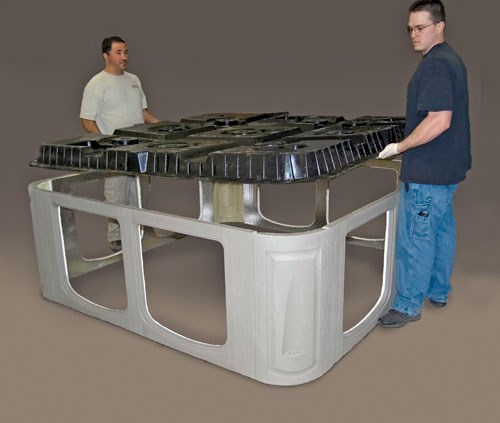Polyurethane long fiber technology (LFT) replaces wood in spa surround
To many consumers, the thought of a relaxing soak in a hot tub is mighty appealing — but the thought of spa maintenance, particularly replacing rotted wood in the spa's cabinet-like enclosure, probably isn't. For spa manufacturer Clearwater Spas (Woodinville, Wash.), that reality and the fact that building decorativ
The traditional means to hide pipes, pumps and other components, wood surrounds look great, but the required framing and assembly of numerous slats is time-consuming, and the resulting cabinetry was heavy and susceptible to the elements. Because the bulky spas had to be trucked long distances to customers, any weight savings would help in handling and transportation costs.
Clearwater first tried extruded synthetic tongue-and-groove material that, while somewhat lighter, still had to be cut to size and, as was true with the wood enclosures, the resulting components had to be attached piece by piece to a structural frame. Unfortunately, this strategy did nothing to reduce labor time and cost.
The company then turned to Bayer MaterialScience LLC (BMS, Pittsburgh, Pa.) for a molded solution. BMS suggested using a trademarked Baydur reinforced polyurethane material, specially formulated for Clearwater (one product under BMS' trademarked BaySystems polyurethane systems umbrella brand), together with a long fiber technology (LFT) molding method. Custom molder Creative Urethanes (Winchester, Va.) was selected to produce the cabinets. BMS, Clearwater and Creative Urethanes collaborated on the cabinet design, which ultimately consisted of four straight sides, each having two removable access panels (for a total of eight panels) and four rounded corner pieces, all assembled using screws or adhesive. Parts would be molded with a simulated wood grain in several colors and in several sizes to accommodate Clearwater's line of spa products — the largest side panel is 72 inches/185 cm long and 34 inches/87 cm high. Molded-in flanges would ensure that parts could be easily aligned and quickly assembled.
The LFT parts had to meet both fire standards and mechanical load-bearing requirements — in addition to offering impact, abrasion and puncture resistance. Finite element analysis (FEA) enabled designers to vary part shapes and details, such as insets for light fixtures in the access panels. Modeling that simulated the handling and transport of a spa showed that the vertical strength of Baydur LFT material easily exceeded performance requirements, even with simulated loads imposed on a side panel directly over an access panel opening.
Baydur STR is a rigid polyurethane, structural-foam material that is reinforced with 0.5-inch up to 4-inch (12.5-mm to 100-mm) long glass fibers. To make the parts, a two-part metal mold is heated to 150°F/302°C and a water-based in-mold paint film 2 to 3 mils thick (which dries to 1.5 mil thick) is applied to the mold cavity. Paint application is followed by a "barrier" spray — a two-component, 100 percent solids (i.e., no VOCs) polyurethane elastomer coating approximately 0.015 mils thick — that performs multiple functions, says Harry George, BMS' market unit head for molded parts. "The barrier spray chemically bonds the paint film to the polyurethane resin," he maintains. "It eliminates any pinholes in the final part, and it adds impact and abrasion resistance as well." Then a robotic mix head equipped with a glass chopper lays down the glass fiber while simultaneously spraying the resin mixture into the mold in a programmed pattern, a process termed open-pour. Cannon USA Inc. (Cranberry Township, Pa.) and KraussMaffei Corp. (Florence, Ky.) supply the automated mix head systems. At the end of the pour, the mold is closed to form the part. According to George, the low-pressure process takes about four minutes, "button to button."
"It's a unique, breakthrough application for spa OEMs," says George. The spa cabinet parts are strong, lightweight, chemical- and water-resistant as well as dimensionally stable, in part, because the Baydur polyurethane has a low coefficient of thermal expansion (CTE) that minimizes swell and shrink when exposed to the weather. Perhaps most important, the automated LFT molding process allows the creation of low- or high-density parts, in varying thickness and glass fiber loading, for either structural or simply decorative purposes, all with a Class A finish.
The more durable and easier-to-assemble spa enclosure saves approximately 300 lb/136 kg per spa — more then 20 percent — when compared to real wood, reports Clearwater Spas.
Company vice president Larry Richards says that the new cabinets are not only beautiful but extremely durable, ensuring that the products are delivered in the same condition they were in when they left the factory, allowing customers to concentrate on a leisurely soak.
Related Content
Materials & Processes: Fibers for composites
The structural properties of composite materials are derived primarily from the fiber reinforcement. Fiber types, their manufacture, their uses and the end-market applications in which they find most use are described.
Read MoreSulapac introduces Sulapac Flow 1.7 to replace PLA, ABS and PP in FDM, FGF
Available as filament and granules for extrusion, new wood composite matches properties yet is compostable, eliminates microplastics and reduces carbon footprint.
Read MoreNovel dry tape for liquid molded composites
MTorres seeks to enable next-gen aircraft and open new markets for composites with low-cost, high-permeability tapes and versatile, high-speed production lines.
Read MoreThe lessons behind OceanGate
Carbon fiber composites faced much criticism in the wake of the OceanGate submersible accident. CW’s publisher Jeff Sloan explains that it’s not that simple.
Read MoreRead Next
CW’s 2024 Top Shops survey offers new approach to benchmarking
Respondents that complete the survey by April 30, 2024, have the chance to be recognized as an honoree.
Read MoreFrom the CW Archives: The tale of the thermoplastic cryotank
In 2006, guest columnist Bob Hartunian related the story of his efforts two decades prior, while at McDonnell Douglas, to develop a thermoplastic composite crytank for hydrogen storage. He learned a lot of lessons.
Read MoreComposites end markets: Energy (2024)
Composites are used widely in oil/gas, wind and other renewable energy applications. Despite market challenges, growth potential and innovation for composites continue.
Read More




















